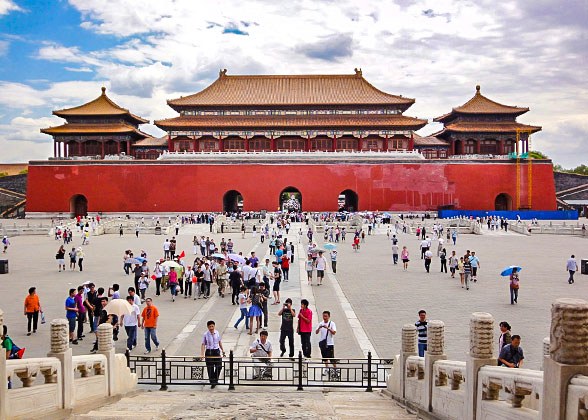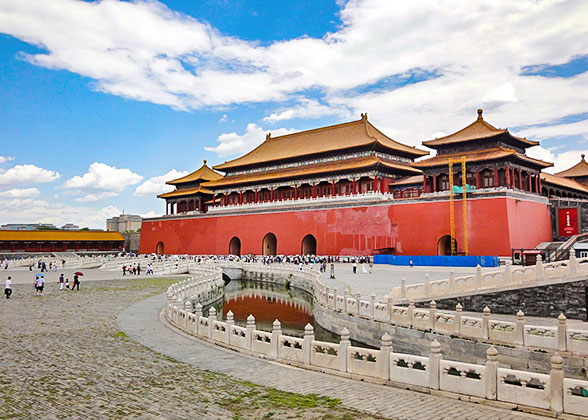Meridian Gate (Wumen)
Wumen in Chinese, the Meridian Gate is the southern gate and the only entrance now to the Forbidden City. After touring Tiananmen Square, tourists can walk through the Tianmenmen Tower (Gate of Heavenly Peace) to the Duanmen Gate, and then get through it and arrive at the square before it. Buy the tickets of the Forbidden City at the booths on either side, and start your tour to this magnificent imperial palace complex of the Ming (1368-1644) and Qing (1644-1911) Dynasties.
Chinese emperors believed that they were the Sons of Heaven and therefore should live at the center of the universe. They believed the Meridian went through the middle of the gate and built the entire Forbidden City symmetrically to this axis, and thus it was named accordingly. Completed at the year of 1420, the Meridian Gate had been repaired for two times in 1647 and 1801.
As the largest and most imposing gate to the Forbidden City, the Meridian Gate has a height of 37.95 meters (124.5 feet). It has a concave layout with five towers appearing like a flying phoenix, which also gives it another name ‘Five-Phoenix Tower’ (Wufenglou). The central tower, with double roofs made of colored glazed tiles, is 60.05 meters (198 feet) in length and 25 meters (82 feet) in width. It is on a 12 meters’ (39 feet) high red abutment, whose frontispiece has three doorways. On the east and west of the central abutment, two corridor-like buildings extend southward, separately connecting two towers with double spires on their ends. There are two smaller doors at the corners of the flanking buildings.
Everyone who entered the Forbidden City had to observe the strict rules concerning the total five doors of the Meridian Gate. The central doorway was for the exclusive use of the emperor in Ming and Qing Dynasties. However, an empress was granted the privilege of using this opening once, and only once, on her wedding day. As a special honor, the top three scholars, who achieved the highest awards in the national examinations presided over by the emperor, would be permitted to march through this door, following their interview with the emperor. The smaller door to the east was used by ministers and officials while that to the west was used by the royal family. The remaining two doors at the corners were only used when there were grand ceremonies. In the ancient time, the entry to and exit from the Forbidden City is very strict for the safety of the imperial members. The ordinary people were forbidden to enter any of the doors. Today, the three central doorways are available for all the tourists. The two side doors now are reconstructed as toilets.
There are bells and drums on the two ends of the central tower. The bells would ring to announce the emperor's departure for the Temple of Heaven, while the drums were struck to announce the departure to the Ancestral Temple. The bells and drums were sounded together when big ceremonies were held in the Hall of Supreme Harmony (Taihedian).
The Meridian Gate is the usual place for the promulgation of the emperors’ rescripts. Besides, a number of special events, ceremonies and festival activities were held here.
In the Ming Dynasty, the emperor would treat the officials on the central tower on the Lantern Festival (Jan. 15 of the lunar calendar). The emperor would bestow various foods to his ministers here on some traditional festivals, including the pastries on the day of the Beginning of Spring (Feb. 4), cold cakes on the Dragon Boat Festival (May 5 of the lunar calendar), and Chongyang Cakes on the Chongyang Festival (Sep. 9 of the lunar calendar). To the left of the Imperial Way which passes through the central entrance is the place where the officials who had offended the emperor would receive punishment by the rod. In 1519, 158 officials dissuaded Emperor Zhu Houzhao from going out to south China for leisure, and 15 of them were beaten to death here. This cruel punishment was abolished in the late Ming Dynasty.
In the Qing Dynasty, the Directorate of Astronomy would submit the almanac of the next year to the emperor and his wives on the first day of the 10th lunar month. The almanac would indicate the days on which various ceremonies would be held. When the troops returned from an important battle in triumph, there would be a grand Captives Sacrifice Ceremony on the square before the Meridian Gate for the emperor to inspect his troops and promulgate the punishment on the captives. For a saying of ‘beheading someone out of the Meridian Gate’ which is especially popular used in some Chinese novels, films and television series, it is just a rumor. Actually, the execution of the criminals is held in Caishikou, a once busy local vegetable market and the present area around the Caishikou Department Store in Xuanwu District.
 Next:
Next:
Passing the Meridian Gate and walking through the Inner Golden River Bridges, you will see the huge square in front of the spectacular Three Palaces of the Outer Court of the Forbidden City.
If you want to tour along the central axis, you can go straight forward to the Gate of Supreme Harmony (Taihemen).
If your schedule is not tight, some side buildings are also worth a visit. To the east of the bridges is the Gate of Unified Harmony leading to the Hall of Literary Glory (Wenhuadian). To the west is the Gate of Prosperous Harmony leading to the Hall of Martial Valor (Wuyingdian).
 Further Reading:
Further Reading:
How to visit the Forbidden City
Chinese emperors believed that they were the Sons of Heaven and therefore should live at the center of the universe. They believed the Meridian went through the middle of the gate and built the entire Forbidden City symmetrically to this axis, and thus it was named accordingly. Completed at the year of 1420, the Meridian Gate had been repaired for two times in 1647 and 1801.
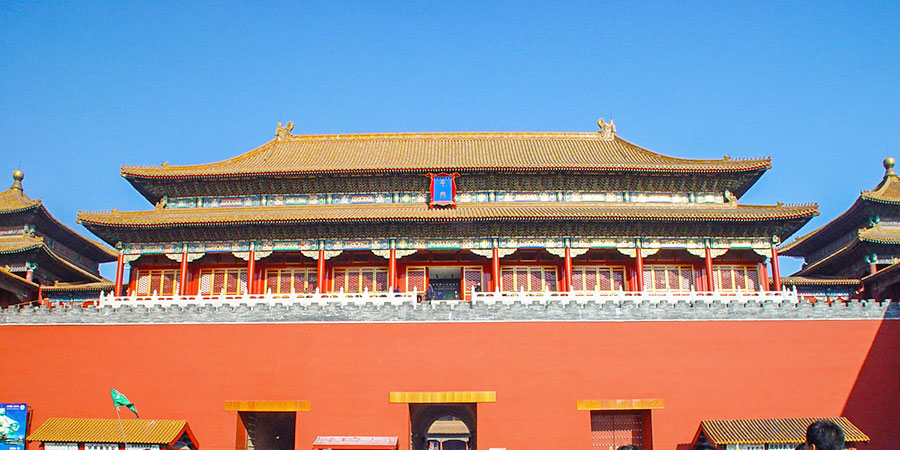 |
Structure
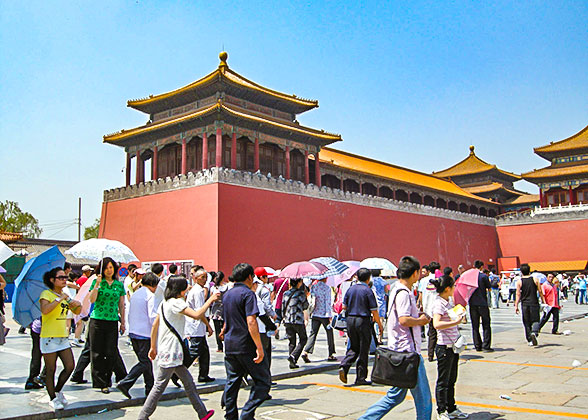 |
| Solemn Tower |
Everyone who entered the Forbidden City had to observe the strict rules concerning the total five doors of the Meridian Gate. The central doorway was for the exclusive use of the emperor in Ming and Qing Dynasties. However, an empress was granted the privilege of using this opening once, and only once, on her wedding day. As a special honor, the top three scholars, who achieved the highest awards in the national examinations presided over by the emperor, would be permitted to march through this door, following their interview with the emperor. The smaller door to the east was used by ministers and officials while that to the west was used by the royal family. The remaining two doors at the corners were only used when there were grand ceremonies. In the ancient time, the entry to and exit from the Forbidden City is very strict for the safety of the imperial members. The ordinary people were forbidden to enter any of the doors. Today, the three central doorways are available for all the tourists. The two side doors now are reconstructed as toilets.
There are bells and drums on the two ends of the central tower. The bells would ring to announce the emperor's departure for the Temple of Heaven, while the drums were struck to announce the departure to the Ancestral Temple. The bells and drums were sounded together when big ceremonies were held in the Hall of Supreme Harmony (Taihedian).
Usage
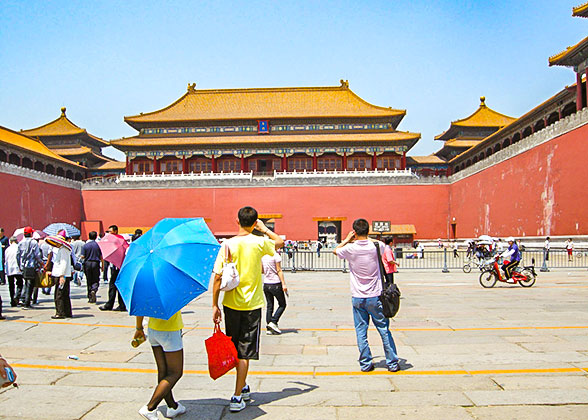 |
In the Ming Dynasty, the emperor would treat the officials on the central tower on the Lantern Festival (Jan. 15 of the lunar calendar). The emperor would bestow various foods to his ministers here on some traditional festivals, including the pastries on the day of the Beginning of Spring (Feb. 4), cold cakes on the Dragon Boat Festival (May 5 of the lunar calendar), and Chongyang Cakes on the Chongyang Festival (Sep. 9 of the lunar calendar). To the left of the Imperial Way which passes through the central entrance is the place where the officials who had offended the emperor would receive punishment by the rod. In 1519, 158 officials dissuaded Emperor Zhu Houzhao from going out to south China for leisure, and 15 of them were beaten to death here. This cruel punishment was abolished in the late Ming Dynasty.
In the Qing Dynasty, the Directorate of Astronomy would submit the almanac of the next year to the emperor and his wives on the first day of the 10th lunar month. The almanac would indicate the days on which various ceremonies would be held. When the troops returned from an important battle in triumph, there would be a grand Captives Sacrifice Ceremony on the square before the Meridian Gate for the emperor to inspect his troops and promulgate the punishment on the captives. For a saying of ‘beheading someone out of the Meridian Gate’ which is especially popular used in some Chinese novels, films and television series, it is just a rumor. Actually, the execution of the criminals is held in Caishikou, a once busy local vegetable market and the present area around the Caishikou Department Store in Xuanwu District.
|
|
Passing the Meridian Gate and walking through the Inner Golden River Bridges, you will see the huge square in front of the spectacular Three Palaces of the Outer Court of the Forbidden City.
If you want to tour along the central axis, you can go straight forward to the Gate of Supreme Harmony (Taihemen).
If your schedule is not tight, some side buildings are also worth a visit. To the east of the bridges is the Gate of Unified Harmony leading to the Hall of Literary Glory (Wenhuadian). To the west is the Gate of Prosperous Harmony leading to the Hall of Martial Valor (Wuyingdian).
How to visit the Forbidden City
- Last updated on Aug. 16, 2024 by Gabby Li -
